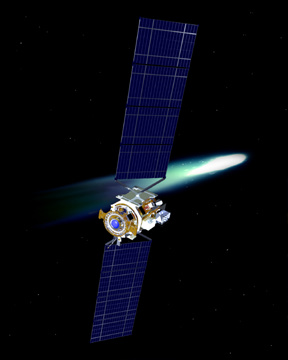The NASA Mission Information Page by Jeffry J. Brickley
This page hosted by
Last Updated: 11/16/99.
Since 09-28-98, this page has been accessed:
The NASA Mission Information Page by Jeffry J.
Brickley
This page hosted by ![]() Get your own Free Home Page
Get your own Free Home Page
Last Updated: 11/16/99.
Since 09-28-98, this page has been accessed: times!
 The Deep Space
One spacecraft successfully launched on October 24, 1998 to travel to asteroid 1992 KD in
July 1999. DS1 is the first scheduled mission in the NASA New Millennium program, which is
designed to test and validate cutting edge technology for the systems and instruments
on-board future NASA science spacecraft. The artificial intelligence (AI), Remote Agent,
software on board DS1 is being developed at NASA Ames Research Center in collaboration
with spacecraft engineers and computer scientists at the Jet Propulsion Laboratory (JPL),
Pasadena, CA. Remote Agent is the first AI system that will control a spacecraft.
The Deep Space
One spacecraft successfully launched on October 24, 1998 to travel to asteroid 1992 KD in
July 1999. DS1 is the first scheduled mission in the NASA New Millennium program, which is
designed to test and validate cutting edge technology for the systems and instruments
on-board future NASA science spacecraft. The artificial intelligence (AI), Remote Agent,
software on board DS1 is being developed at NASA Ames Research Center in collaboration
with spacecraft engineers and computer scientists at the Jet Propulsion Laboratory (JPL),
Pasadena, CA. Remote Agent is the first AI system that will control a spacecraft.
The primary mission concludes in September 1999. If the spacecraft is healthy and NASA continues the mission, the spacecraft may be on a path that would allow an encounter with comet Wilson-Harrington and comet Borrelly in 2001.
The ion propulsion system on NASA's Deep Space 1 spacecraft came to life Tuesday, Nov. 24, and has continued running smoothly since. The engine started up at 5:53 p.m. EST, in response to commands sent to the spacecraft. After running overnight in low- thrust mode, engineers commanded the engine to switch to higher- thrust modes today. The mission team plans to leave the engine running over the four-day Thanksgiving weekend.
The fuel used in Deep Space 1's ion engine is xenon, a colorless, odorless and tasteless gas more than 4-1/2 times heavier than air. When the ion engine is running, electrons are emitted from a hollow bar called a cathode into a chamber ringed by magnets, much like the cathode in a TV picture tube or computer monitor. The electrons strike atoms of xenon, knocking away one of the 54 electrons orbiting each atom's nucleus. This leaves each atom one electron short, giving it a net positive charge -- making the atom what is known as an ion.
At the rear of the chamber is a pair of metal grids which are charged positive and negative, respectively, with up to 1,280 volts of electric potential. The force of this electric charge exerts a strong "electrostatic" pull on the xenon ions - much like the way that bits of lint are pulled to a pocket comb that has been given a static electricity charge by rubbing it on wool on a dry day. The electrostatic force in the ion engine's chamber, however, is much more powerful, causing the xenon ions to shoot past at a speed of more than 60,000 miles per hour (100,000 kilometers per hour), continuing right on out the back of the engine and into space.
At full throttle, the ion engine would consume about 2,500 watts of electrical power and puts out 1/50th of a pound (90 millinewtons) of thrust. This is comparable to the force exerted by a single sheet of paper resting on the palm of a hand.
How then could a craft with an engine so weak pilot across our solar system? Two reasons, the first is that in space, away from the gravitational pull of the earth, very little power is required to move around.... And the second and most important is that the ion engine of Deep Space 1 is designed to run continuously over long periods of time! This is, perhaps the greatest leap in technology that NASA has ever tried. Current methods of accelleration using solid or liquid propellant being burned is FAST and SHORT. Ion propulsion offers patient steady accelleration over days and even months to achieve speeds not possible without large expenditures of burned fuel!
For more information one Deep Space One, read the NASA press release, or visit the Official Deep Space One Site.
For more information on New Millennium Software read the NASA press release.